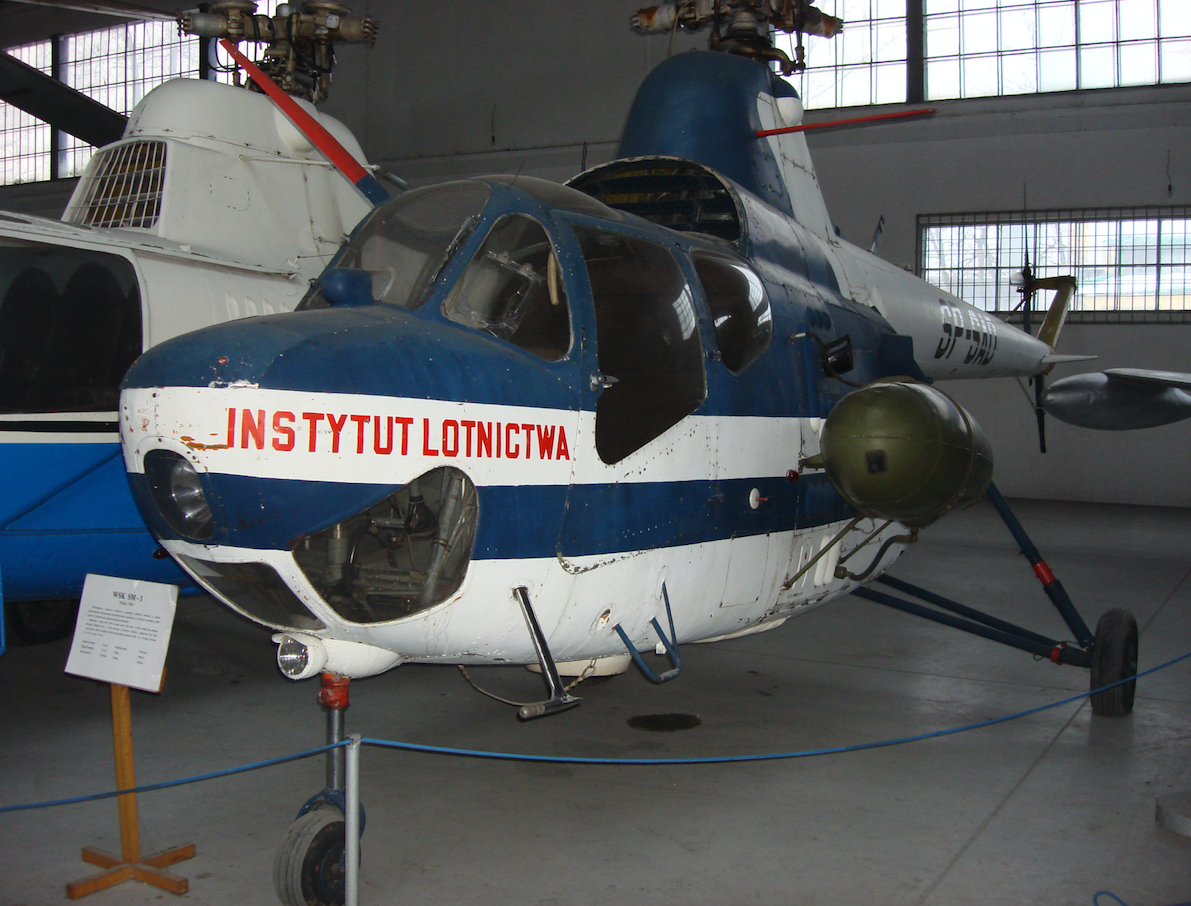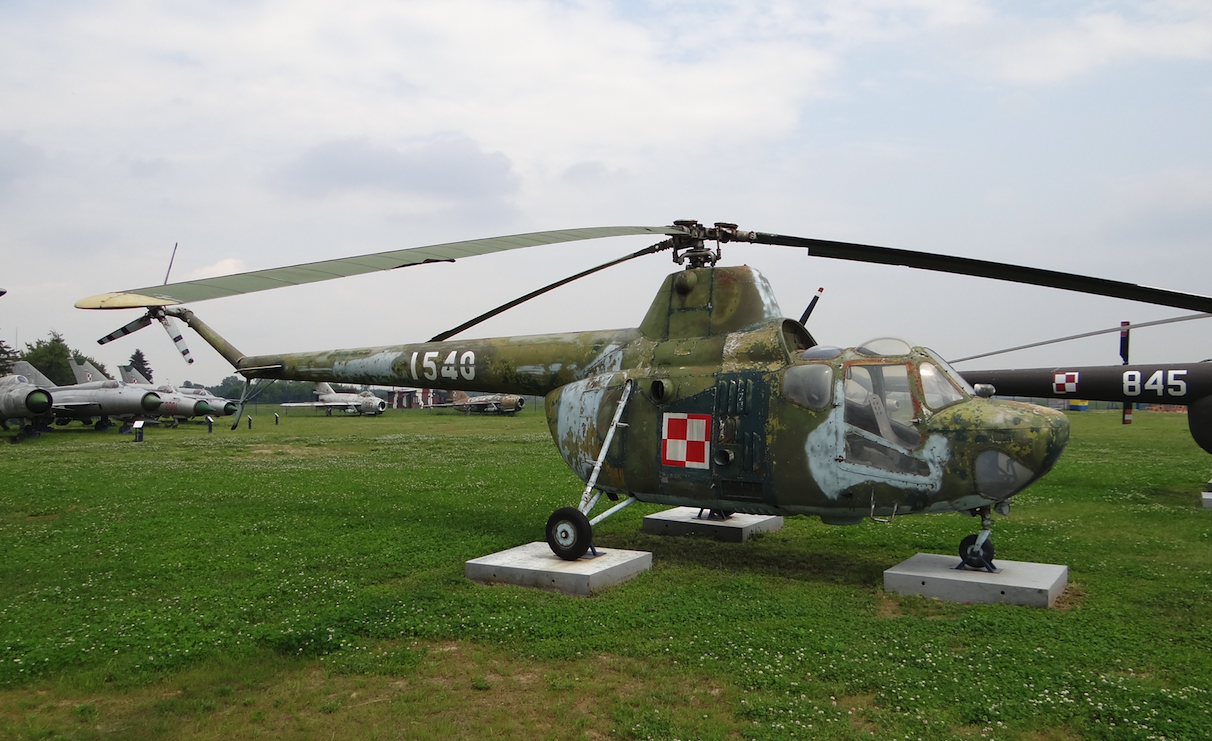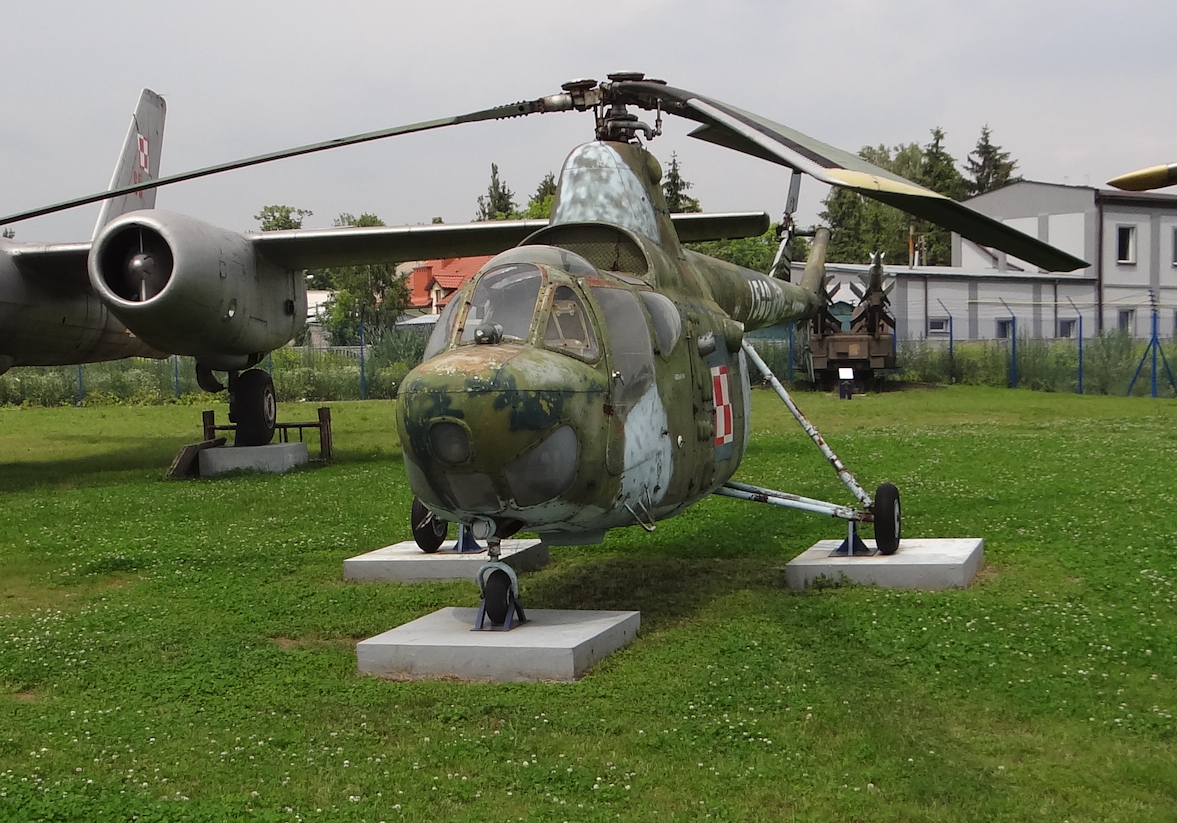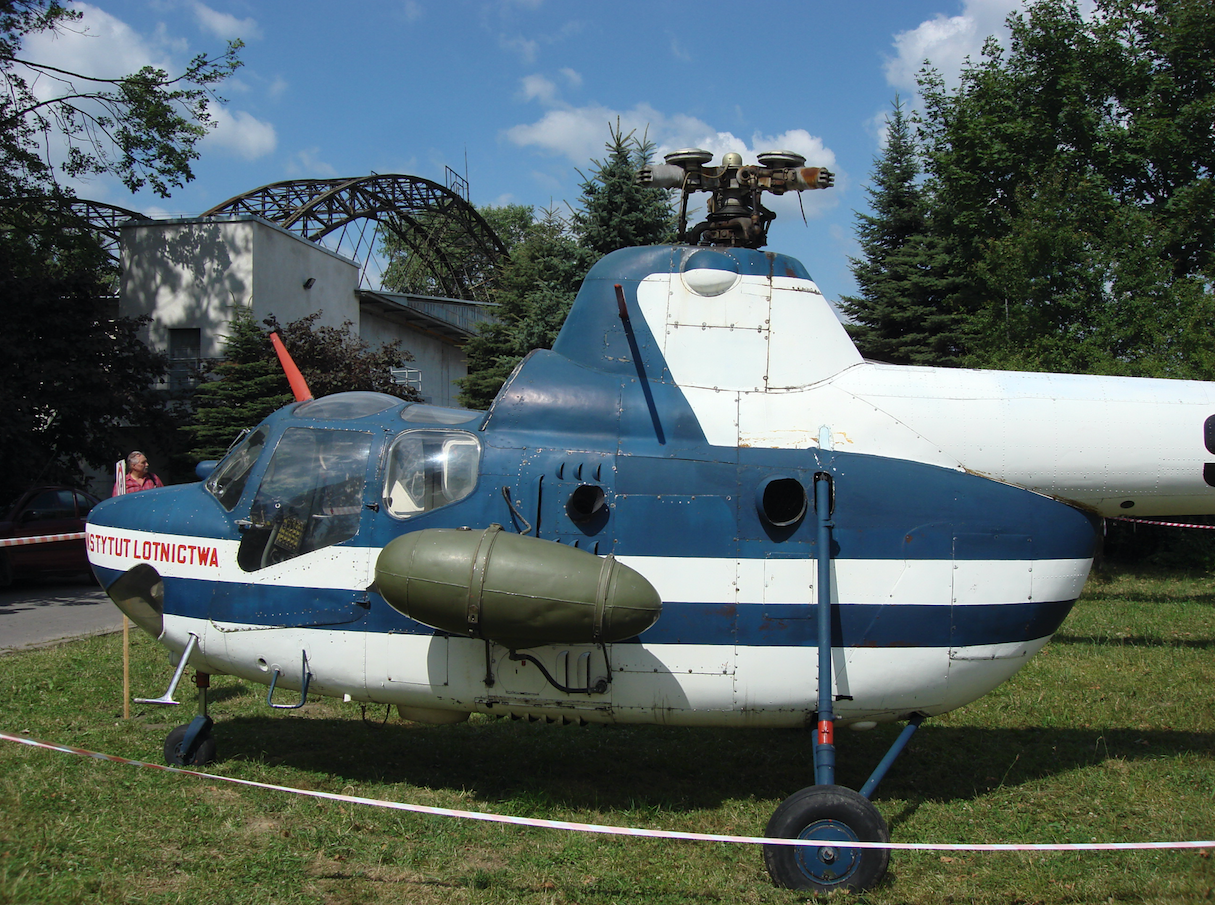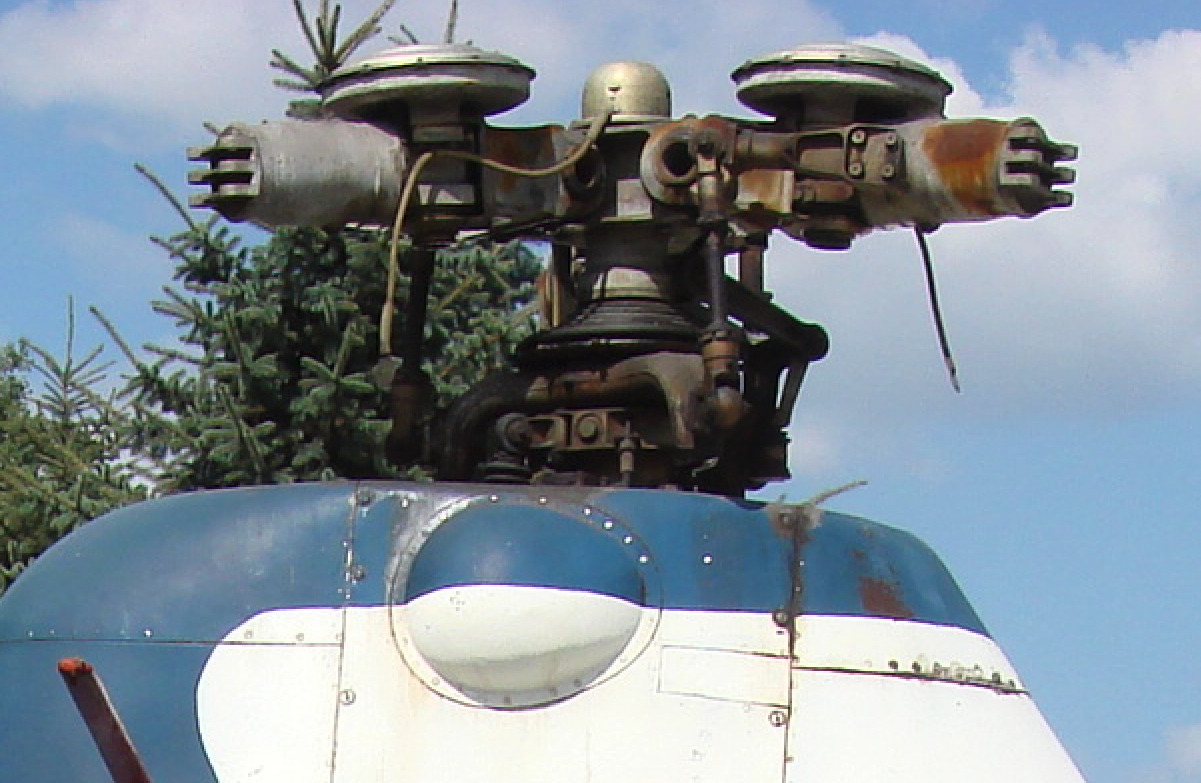Kraków 2018-01-03
130a Section 23.03.1956r.
PZL WSK Świdnik SM-1.
The SM-1 helicopter is a licensed Mil Mi-1 helicopter, which was produced by WSK PZL Świdnik.
The first utility helicopters in the world appeared in 1942. This fact meant that in 1947 CCCP established a design facility under the direction of Mikhail Leontjewicz Mil, who held the position of director of this facility. The facility was merely a design office at Factory No. 329 in Moscow. In other words, it did not have such powers as Tupolev’s OKB or Mikojan and Guriewicz’s OKB. In addition, the interference of the factory director in the work of the office was large.
Mikhail Leontievich Mil was a very weak engineer. He could not even use the slide rule, which was the basic tool of an engineer’s work in the 1950s. Mikhail Mil made the calculations very roughly. When he received it, the slider placed it in a place of honor among its trophies as a gift. Brawerman was responsible for the calculations in Mikhail Mil’s team.
Nevertheless, Mikhail Mil had a talent for design. He was able to solve emerging problems with amazing ease. A great help in this was his unconventional approach to the problem. His design vision was not burdened with established patterns of behavior. Importantly, it was effective. When he was absent from work due to illness, work would stop.
Soon, work began on the first design of the helicopter, designated GM-1 (ГМ-1, Геликоптер Миля-1, Gielikoptier Mila). The helicopter was to be a multipurpose machine, because at that time it was not known how to use the specific features of the helicopter. The general concept was adopted from Igor Sikorsky’s helicopters. So a single-rotor system with a tail rotor. The tail rotor solved the problem of the reaction torque, also known as the thrust torque, that affects the helicopter fuselage and comes from the main rotor drive. The blades of the main rotor and the tail rotor are made of steel and pine wood.
The helicopter was more of an experimental construction than a utility one. Therefore, work on it progressed quickly. The main focus was on the control system, almost completely ignoring the pilot instruments. After all, the flights were to be performed only in good weather conditions.
The first prototype was built in September 1948. The flight of the machine took place on September 30, 1948 at the Tuszyn Airport (Zakharkowo), with the pilot M. K. Baikalov at the controls. Then factory trials began, during which two prototypes were lost. One was executed on November 24, 1948, during a flight to the dynamic ceiling at an altitude of 5,200 m. The reason for this was the lubricant freezing in the control system mechanisms, the pilot Baikalov saved himself by jumping with a parachute. The second prototype was crashed while flying over the airport on March 7, 1949. At one point, the helicopter unexpectedly took a sharp turn and fell to the ground. The Baikal pilot was killed on the spot. The cause of the crash was the incorrect execution of the tail rotor shaft.
Factory trials were completed in 1949, after which the helicopter was sent to state tests. The attempts were successful, so on February 15, 1950, the CCCP Council of Ministers approved the helicopter for mass production, at the same time giving it the designation Mil Mi-1.
At the same time, work was carried out at the OKB Yakovlev design office on a competitive helicopter, designated Yak-100. The machine was very similar to the Mil Mi-1 and was powered by an identical engine. It only had a slightly larger cabin, similar to the later SM-2 helicopter. Due to technical problems, work on the Yak-100 was protracted. It wasn’t until the mid-1950s that the Yak-100 went to state trials. They turned out positively and the helicopter was recommended for serial production. Serial production of the Yak-100, however, was not undertaken, because at that time it was already in serial production of the Mil Mi-1. NATO Hare designation, meaning the hare.
Plant No. 329 in Moscow was selected for serial production, where the research facility of Mikhail Mila was located. Already during the production of the first batch of 15 Mil Mi-1 helicopters, the main rotor and control system were modified. The control system uses new gear ratios that reduce the forces on the joysticks and reduce the risk of failure.
In 1950, a version of the training helicopter was developed, designated the Mi-1 U. It was equipped with duplicate controls. The instructor sat slightly behind the student to the left.
Mil Mi-1 helicopters from the first series were presented in 1951 at the air show in Tuszyn (Zacharków). The helicopter did not enjoy much military interest. They just did not see an application for this type of machine in military operations. However, the use of helicopters in the Korean War by the USAF in evacuation operations and the personal interest of Stalin’s dictator forced the generals to place orders for Mil Mi-1 helicopters.
In 1953, Michał Mil already had a lot of information about the advantages and shortcomings of the Mil Mi-1 helicopter. It became necessary to develop an anti-icing system to make the helicopter less sensitive to changing weather conditions. The entrance door to the cabin was also enlarged so that an armed soldier could easily get into it.
By the way, a modified engine was installed in the helicopter. This helicopter, as the Mi-1 T, was produced in the period 1954-1958. In total, nearly 600 helicopters in this version were built. The Mi-1 T helicopter has blades developed in 1953 with a service life of 300 hours, and an AI-26 W engine with 575 hp.
Subsequent versions were given the option of installing additional fuel tanks and the service life of some helicopter components was extended. In 1957, new laminated main rotor blades were developed. Once again, the power unit was modified by installing a less emergency AI-26 GRF engine, 575 HP. This change necessitated the modernization of the helicopter hull. The hull was slightly widened. Thanks to this, there were three people on the rear seat instead of two. About 370 Mi-1 A and Mi-1 M helicopters were built, but some of the helicopters were built by rebuilding earlier versions.
In total, over 1,000 Mil Mi-1 helicopters have been built in the CCCP. They were produced in Moscow in Plant No. 329, Plant No. 387 in Kazan, Plant No. 47 in Orenburg, Plant No. 168 in Rostov. In Poland, 1,594 SM-1 helicopters were built at WSK PZL Świdnik.
In CCCP, the Mil Mi-1 helicopters were used for the following purposes: liaison, correcting artillery fire, evacuating the wounded (including a typical Mi-1 sanitary version with a gondola for a patient on a stretcher), agricultural, landing on water bodies with floats and for transporting passengers called Mi -1 Moskvich.
Users: Poland, Czechoslovakia, Cuba, Albania, Hungary, East Germany, Bulgaria. Iraq, Syria, Yemen, Finland, Indonesia, Afghanistan, China. About 2,500 Mil Mi-1 helicopters were operated worldwide.
Mi-1 (SM-1) in Poland.
After the international situation changed at the end of 40 years, the authorities of the Polish People’s Republic (People’s Republic of Poland) decided to build a new armaments plant, which was to produce combat aircraft. Based on the aviation tradition of Lublin (Zakłady Mechaniczne Emil Plage and Teofil Laśkiewicz in Lublin, later Lublin Aircraft Factory), it was decided to locate a new factory near Lublin in Świdnik.
On January 1, 1951, the Central Management Board of the Communication Equipment Industry in Warsaw, based on the Resolution of the Council of Ministers, Order of the Minister of Heavy Industry of December 14, 1950, established the WSK Plant No. 5 in Świdnik. Construction work began in 1950, and the main facilities were commissioned in 1953. Several facilities were built from the structure of hangars dismantled at the Krzesiny Airport near Poznań.
The plant was to be the final producer of Lim-1 fighters (licensed MiG-15). In this direction, the purchase of appropriate machinery and equipment was made. The production was launched, and soon it was decided that the final assembly of the Lim-1 aircraft would take place at WSK PZL Mielec, which was initially to be only a subcontractor. There were also plans that both factories could be the final producer should the need arise. The final decisions were made at the end of 1952 at the Central Management Board of the Communication Equipment Industry in Warsaw. The production of some airframe elements was left at WSK Świdnik. Wings, ballasts, engine mounts, a gun carrier and a pilot’s seat were produced in Świdnik. In 1952, the first wings and tail were produced, and in 1953, the rear fuselage.
As early as 1953, discussions were held in Warsaw as to the production profile of the factory in Świdnik. The launch of the production of refrigeration compressors and the serial production of the TS-8 Bies were considered. In 1954, the authorities of the Polish People’s Republic decided that the plant would become the main helicopter factory, as a decision had already been made to produce Mil Mi-1 helicopters.
Helicopters were then a technical novelty, although 10 years have passed since the start of serial production of helicopters in the USA. Helicopters have become the symbol of Świdnik. As in the case of the Lim-1 production launch, the translation of the Russian Mi-1 documentation into Polish began. Documentation was adjusted to Polish standards and production conditions.
In 1955, the technical documentation for the helicopter was delivered and employee training began. At the same time, parts of the helicopters were delivered by rail. The first four Mi-1 helicopters were assembled in 1956, from parts supplied by the licensor. The first helicopter was flew on March 23, 1956, and the test pilot was Vsevolod Winnicki.
The first serial helicopters produced entirely in Świdnik began to leave the plant in 1957. The flight of the first helicopter, completely manufactured in Świdnik, took place on March 22, 1957, with Capt. Janusz Ochalik. At this point, PZL WSK Świdnik became the sixth manufacturer of helicopters in the world, quickly entering the top three in terms of production volume.
Initially, the AI-26W engines were delivered from CCCP, but at the end of 1957, their licensed production began at WSK Rzeszów. They were given the Polish designation Lit-3.
The series SM-1 helicopters were first presented to the public on September 8, 1957, at Babice / Bemowo Airport, during the central celebration of the Aviation Day.
The production of SM-1 helicopters in Świdnik lasted from 1956 to 1965. About 90% of the production went to CCCP. In addition, helicopters were exported to Czechoslovakia, East Germany, Hungary, Indonesia, Finland and Bulgaria.
The first version of the SM-1 was a license of the Mi-1 T helicopter. It had a main rotor blade with a service life of 150 hours. From 1957, SM-1/300 helicopters were produced, i.e. with blades with a service life of 300 hours. As early as 1958, the SM-1/600 helicopters were built, i.e. with blades with a service life of 600 hours. In 1963, the SM-1 Wb helicopter began to be produced, which had a main rotor blade with a service life of 800 hours. Additionally, a hydraulic system appeared in the steering assistance system.
Specialized versions of the SM-1 helicopter were built in Świdnik. There was a version for transporting sick people on a stretcher in an additional side gondola. The contact with the patient was through a very practical sleeve. This method of transport was not very comfortable for the patient and the medical staff. Interestingly, the side gondolas were excellent external racks for transporting small goods. In this way, it was possible to use the maximum capacity of the helicopter.
A crane variant with a lifting capacity of 120 kg was also produced. This variant made it possible to pick up a person from land or water and board a helicopter. School variant with double controls. Agricultural variant for spraying or dusting farmland.
Work was also carried out on the version of the SM-1 with wings. This task was commissioned by the Institute of Aviation in 1971. The aim was to show the advantages and disadvantages of such a system. In the future, it was planned to use these wings as places for junctions for armaments or additional fuel tanks.
SM-1 as a symbol of Świdnik.
In 1979, on the occasion of the 25th anniversary of granting municipal rights to the City of Świdnik, at Przodników Pracy Street (today’s Lotników Polskich Street, at the Świdnicki Lipca roundabout), the SM-1 was placed on a metal plinth. The monument in the form of the first helicopter produced at the aviation plant in Świdnik has become a landmark and a landmark of the city over the years.
SM-2 helicopter.
On the basis of the Mi-1 helicopter, the SM-2 helicopter was developed, which had much greater transport capabilities. The SM-2 helicopter was developed in 1959, and the main modification was a redesign of the cabin, which has grown significantly.See separate chapter.
Construction Mil Mi-1 / PZL SM-1.
The Mi-1 / SM-1 helicopter is a light, single-engine aircraft built in a classic layout, with the main rotor and tail rotor. It takes a pilot and two passengers on board. All metal construction.
The fuselage consists of a cabin, an engine compartment and a tail boom. The hull is made of a spatial truss made of pipes made of chrome-nickel-molybdenum steel (1.4401). The cover is made of duralumin sheet. The cabin has a rich glazing with organic glass (acrylic glass, plexiglass) convex shape to improve visibility. The windshield of the cabin is made of quartz glass, it is flat and has a wiper. The rear fuselage houses the engine, final drive, 240 liter fuel tank, 32 liter oil tank and other equipment, including a radio altimeter. The tail boom has a semi-shell structure. The cabin is separated from the engine compartment by a partition made of 0.6 mm thick duralumin sheet. It was covered with sound-absorbing insulating materials and fire-resistant fabric for sound and fire insulation.
Main rotor.
Three-blade main rotor. Initially, the main rotor blades were made of metal and wood with a metal cap on the leading edge. The rotors diameter was 14.35 m (47 ft 1 in). Drive wheel area 161.70 m² (1.740 ft²). At the end of the 50s, metal blades began to be tested. The first blades had a service life of 150 operating hours. It was then increased to 300 hours, and eventually to 600 hours.
Three-blade tail rotor. Head made of metal. The shovels are made of wood.
A three-support chassis with a front wheel. The construction uses oil-air shock absorbers. The front undercarriage is single-leg, self-aligning. A skid is attached to the tail boom, which acts as a bumper to prevent the tail rotor from hitting the ground.
The anti-icing system was used only from the version of the Mi-1 T helicopter. It is of the liquid type. It consists of a spirit tank with a capacity of 28 liters. The installation protects the main rotor, tail rotor and windshield of the cabin. De-icing of the main rotor blades consists in introducing the spirit into a channel in the metal cover of the blade and discharging it through numerous holes on the leading edge of the cover. Additionally, there are small grooves where the spirit is to flow. Similarly, the tail rotor blades are de-iced. Windshield de-icing is carried out by sprinklers located above the top frame of the window or on the side. The helicopter has no icing alarm. The pilot decided to use the installation, guided by his experience, the thermometer reading or when he saw ice on the windshield.
The first version of the Mi-1 helicopter was quite modestly equipped with piloting devices. However, even subsequent versions were well equipped. The SM-1 helicopter has; VHF radio station, automatic ARK-5 radiocompass, GIK-1 gyro-induction compass, RW-2 radio altimeter.
Engine.
7-cylinder AI-26 GR type piston engine, air-cooled by an additional fan. The engine has a power of 550 HP. Via the main gear, it drives the main rotor and the tail rotor.
The oil tank has a capacity of 32 liters and there are two coolers on both sides of the hull to cool the oil.
T-T data of the SM-1 helicopter:
The rotors had a diameter of 14.35 m (47.08 ft). Drive wheel area 161.70 m² (1.740 ft²). Overall length 16.97 m (55.68 ft). Hull length 12.08 m (39.63 ft). Height 3.30 m (10.83 ft). Curb weight: 1,785 kg (3,740 lb). Takeoff weight 2,330 kg (5,126 lb). Load weight 255 kg (561 lb). Fuel 240 liters + 135 liters. Max speed 185 km / h (115 mph). Cruising speed 130 km / h. Rate of climb 5.3 m / s (1.043 ft / min). Service ceiling 3 500 m (11,480 ft). Range 380 – 500 km (205 – 270 nm).
List of PZL SM-1 / Mil Mi-1.
About 1,000 Mil Mi-1 helicopters have been built at CCCP. About 1,594 SM-1 (Mi-1) helicopters were built at WSK PZL Świdnik.
Written by Karol Placha Hetman

